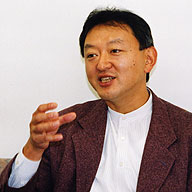An Interview with Kato Itaru
Operation Conbini-bento (Laugh)

Q: This film is a collaborative work between you and co-director Sakurai Atsushi, but what spurred you to make this work?
KI: A friend’s izakaya (Japanese-style bar)-cum-movie theater was doing an event for its tenth anniversary, and they asked if Sakurai and I would make a film about food to screen at the event.
Q: What was your reason for taking up conbini bento (convenience store boxed lunches)?
KI: We do an overnight trip with students, and there was a time when everyone was asked to bring their own bento. When the students took out their bento, most of them had bento from conbini. And it seems this has become Japanese culture. Think about it, having hot bento available around the clock, available to buy anytime. From the perspective of a country dealing with starvation, isn’t it a ridiculous luxury? However, the flip side is that 99% of the people are being made to make that choice, and they aren’t able to choose anything else. So in Japan the culture of mothers and wives making bento for you is disappearing, and this seems like a sad thing. The flip side of this incredible luxury is something that’s incredibly sad, and I wanted to try turning this into a film.
Q: How did the planning and filming proceed?
KI: This time I deliberately had students help out during the production, since it would be good experience, and I wanted them to have a taste of making something enjoyably, without a lot of bluster. First we had students from a seminar class help out with the planning, and participants in the Kokumin Bunkasai (National Cultural Festival) workshop helped with the filming. Thanks to everyone’s efforts, we were able to make something good (laugh).
Q: Did your way of viewing conbini bento change before and after making this piece?
KI: Indeed it did change. I’ve come to eat with respect (laugh). Really it is hard to make that many things in a household. Even when it’s mass produced, you can see corporations making an effort to pay attention to the details, to make something even a little bit nice. But it does nothing to solve the problem of plentitude and poverty.
Q: What was your intention behind the title?
KI: At first the working title was Operation Conbini-bento (laugh), but that would have gone too far. “Warming” is used as an expression of affection, but the conbini’s “shall I warm it up?”—also a key phrase for this work—is such a shameless lie and sounds so fake, so we titled the piece Fake Heating. Then we combined Insect Venom with Fake Heating to get Kaiseki Cuisine, since one of the meanings of kaiseki is “analysis,” and Sakurai wanted to analyze food additives and I wanted to analyze the effort and cost of conbini bento. Also, the two of us were dealing with cheap food products, and the title also ironically refers to the high-class Japanese cuisine called kaiseki. Another meaning is the kaiseki cuisine served in the tea ceremony, to warm up the stomach before the tea is brought out. In this case, the word kaiseki refers to a kind of hot water bottle, where a stone is heated up and wrapped in cloth, and put against the chest for warmth. And that goes back to “shall I warm it up?” It’s truly Kaiseki Cuisine.
(Compiled by Yabe Atsuko)
Interviewers: Yabe Atsuko, Watanuki Mugi
Photography: Watanuki Mugi, Hachiya Ryuhei / Video: Ishikawa Chizuko / 2003-10-09 / in Yamagata
